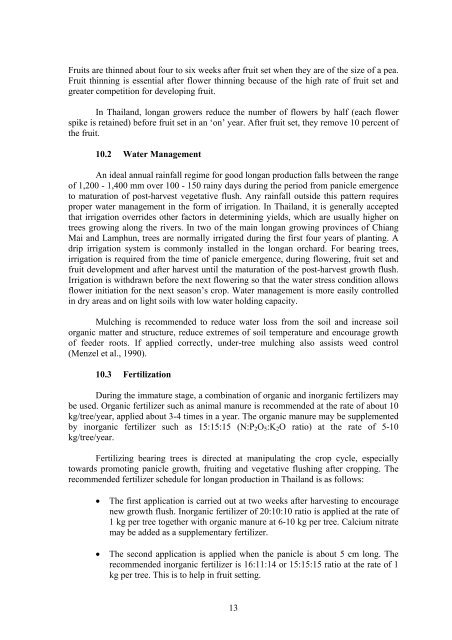Longan production in Asia - United Nations in Indonesia
Longan production in Asia - United Nations in Indonesia
Longan production in Asia - United Nations in Indonesia
You also want an ePaper? Increase the reach of your titles
YUMPU automatically turns print PDFs into web optimized ePapers that Google loves.
Fruits are th<strong>in</strong>ned about four to six weeks after fruit set when they are of the size of a pea.<br />
Fruit th<strong>in</strong>n<strong>in</strong>g is essential after flower th<strong>in</strong>n<strong>in</strong>g because of the high rate of fruit set and<br />
greater competition for develop<strong>in</strong>g fruit.<br />
In Thailand, longan growers reduce the number of flowers by half (each flower<br />
spike is reta<strong>in</strong>ed) before fruit set <strong>in</strong> an ‘on’ year. After fruit set, they remove 10 percent of<br />
the fruit.<br />
10.2 Water Management<br />
An ideal annual ra<strong>in</strong>fall regime for good longan <strong>production</strong> falls between the range<br />
of 1,200 - 1,400 mm over 100 - 150 ra<strong>in</strong>y days dur<strong>in</strong>g the period from panicle emergence<br />
to maturation of post-harvest vegetative flush. Any ra<strong>in</strong>fall outside this pattern requires<br />
proper water management <strong>in</strong> the form of irrigation. In Thailand, it is generally accepted<br />
that irrigation overrides other factors <strong>in</strong> determ<strong>in</strong><strong>in</strong>g yields, which are usually higher on<br />
trees grow<strong>in</strong>g along the rivers. In two of the ma<strong>in</strong> longan grow<strong>in</strong>g prov<strong>in</strong>ces of Chiang<br />
Mai and Lamphun, trees are normally irrigated dur<strong>in</strong>g the first four years of plant<strong>in</strong>g. A<br />
drip irrigation system is commonly <strong>in</strong>stalled <strong>in</strong> the longan orchard. For bear<strong>in</strong>g trees,<br />
irrigation is required from the time of panicle emergence, dur<strong>in</strong>g flower<strong>in</strong>g, fruit set and<br />
fruit development and after harvest until the maturation of the post-harvest growth flush.<br />
Irrigation is withdrawn before the next flower<strong>in</strong>g so that the water stress condition allows<br />
flower <strong>in</strong>itiation for the next season’s crop. Water management is more easily controlled<br />
<strong>in</strong> dry areas and on light soils with low water hold<strong>in</strong>g capacity.<br />
Mulch<strong>in</strong>g is recommended to reduce water loss from the soil and <strong>in</strong>crease soil<br />
organic matter and structure, reduce extremes of soil temperature and encourage growth<br />
of feeder roots. If applied correctly, under-tree mulch<strong>in</strong>g also assists weed control<br />
(Menzel et al., 1990).<br />
10.3 Fertilization<br />
Dur<strong>in</strong>g the immature stage, a comb<strong>in</strong>ation of organic and <strong>in</strong>organic fertilizers may<br />
be used. Organic fertilizer such as animal manure is recommended at the rate of about 10<br />
kg/tree/year, applied about 3-4 times <strong>in</strong> a year. The organic manure may be supplemented<br />
by <strong>in</strong>organic fertilizer such as 15:15:15 (N:P 2 O 5 :K 2 O ratio) at the rate of 5-10<br />
kg/tree/year.<br />
Fertiliz<strong>in</strong>g bear<strong>in</strong>g trees is directed at manipulat<strong>in</strong>g the crop cycle, especially<br />
towards promot<strong>in</strong>g panicle growth, fruit<strong>in</strong>g and vegetative flush<strong>in</strong>g after cropp<strong>in</strong>g. The<br />
recommended fertilizer schedule for longan <strong>production</strong> <strong>in</strong> Thailand is as follows:<br />
• The first application is carried out at two weeks after harvest<strong>in</strong>g to encourage<br />
new growth flush. Inorganic fertilizer of 20:10:10 ratio is applied at the rate of<br />
1 kg per tree together with organic manure at 6-10 kg per tree. Calcium nitrate<br />
may be added as a supplementary fertilizer.<br />
• The second application is applied when the panicle is about 5 cm long. The<br />
recommended <strong>in</strong>organic fertilizer is 16:11:14 or 15:15:15 ratio at the rate of 1<br />
kg per tree. This is to help <strong>in</strong> fruit sett<strong>in</strong>g.<br />
13
















